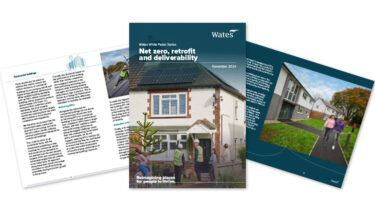
The impact of the Chancellor’s pledge to commit £6bn to energy efficiency retrofit
As the dust settles on the Autumn Statement, David Morgan, Executive Managing Director at Wates Property Services, shares his thoughts on the impact of the Chancellor’s pledge to commit £6bn to energy efficiency retrofit and the necessary steps to realise the Government’s decarbonisation ambitions
At Wates we have delivered over 20 PAS 2035 compliant domestic retrofit schemes to date
We of course welcomed the news from the Autumn Statement that the Government plans to commit a further £6bn to reduce energy consumption from buildings by 15% by 2030 and, crucially, to tackle fuel poverty. In addition, the Government has now announced an extral £1bn to insulate the UK’s most inefficient homes through its ECO+ scheme. We must now waste no time in opening up the conversation on how we ensure we have the capacity to deliver on this pledge. We are building an industry around the Government’s net zero targets, and to make this work, there needs to be a robust infrastructure in terms of skills and supply chain.
Installing energy efficiency measures in nearly 3,000 homes, and what we have come to find is that the pipeline, compliance and funding are constantly evolving. The industry needs to keep pace. By its very nature, PAS 2035 requires a huge skills investment on which the industry is in danger of falling short.
We have supported some of our local supply chain partners in achieving the PAS 2030 standard required of them, and this has been a fantastic way of opening up a new workstream for them while ensuring we have a retrofit compliant supply chain network. In doing so we’ve built a supply chain with the capacity to deliver retrofits to 100k homes over the next two years, but we have only scratched the surface. Alongside the funding pledge from the Government, we need to see plans of how they will fulfil their commitment to strengthening the UK’s green tech industry. The Chancellor committed to accelerating homegrown renewable initiatives such as offshore wind and carbon capture, but the Government also needs to look to the small SME businesses that desperately need fasttrack support to become retrofit compliant.
Taking notice of research on retrofit will also be extremely vital. Recently, the New Economics Foundation* published research that showed that emergency retrofitting of draughty homes could save £6.3bn for households, potentially saving families £260 a year on energy bills. This research was accompanied by a suggestion that the Government could roll out emergency loft and cavity wall insulation for 77% of the money they are spending on the energy price cap. This intelligence is so valuable and needs to feed into the Government’s strategy to tackle climate change and reduce energy bills.
When it comes to energy efficiency retrofit, what we have quickly come to realise is that it’s essential we take a holistic approach to buildings. Approximately 80% of our current buildings will still be around in 2050, and we need to focus on both the domestic sector as well as the non-domestic sector, where 89% of buildings need to be retrofitted by 2030. The additional funding committed by the Government will significantly boost the important work being done by social landlords to decarbonise the millions of social housing properties across the UK, as well as providing the focus required by non-domestic landlords to decarbonise their portfolios and transition to a low-carbon future.
Needless to say, funding is the starting point when it comes to investments of this scale. Initiatives such as the Social Housing Decarbonisation Fund, which is due to enter its second wave in the coming months, have proven the scale of what’s possible. What we need to see now, from the Government and across our industry, are measures to support the necessary growth of the green supply chain, enhanced capital allowances for retrofit and investment in the skills needed to deliver on these ambitions.






